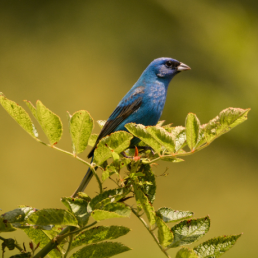

Join BirdNote tomorrow, November 30th!
Illustrator David Sibley and actor H. Jon Benjamin will face off in the bird illustration battle of the century during BirdNote's Year-end Celebration and Auction!
As the sun sets over New York City, author Helen Macdonald takes in the wonders of spring migration from the top of the Empire State Building. She watches a long procession of songbirds pass overhead, but her joy is dampened when she notices some of the birds circling endlessly around the building’s brilliant beacon. Turning off the blaring lights of city skylines — and even suburban homes — can help protect migratory birds at night.
Today's show brought to you by the Bobolink Foundation.
BirdNote®
Watching Migration from the Empire State Building
Written by Ariana Remmel
This is BirdNote.
[Rhapsody in Blue]
As the sun sets over New York City, author Helen Macdonald makes her way to the top of the Empire State Building, not to view the sprawling metropolis, but to take in the wonders of spring migration from an incredible vantage point, high up in the open sky.
Macdonald writes in her collection of essays, Vesper Flights, that, “For every larger bird I see, thirty or more songbirds pass over.
They are very small. Watching their passage is almost too moving to bear. They resemble stars, embers, slow tracer fire.”
But her joy is dampened when she notices some of the birds circling endlessly around the building’s brilliant beacon.
“These birds have been attracted to it,” she writes, “pulled off course, their exquisite machinery overwhelmed by light, leaving them confused and in considerable danger. After being mesmerized in this way, some birds drag themselves free and continue their journey. Others don’t.”
Turning off the blaring lights of city skylines — and even suburban homes — can help protect migratory birds at night. For resources on how to reduce light pollution and forecast bird migration in your region, start at our website: BirdNote.org.
I’m Ariana Remmel.
Today’s show brought to you by the Bobolink Foundation.
###
Senior Producer: John Kessler
Production Manager: Allison Wilson
Producer: Mark Bramhill
Associate Producer: Ellen Blackstone
Digital Producer: Conor Gearin
Bird sounds provided by The Macaulay Library of Natural Sounds at the Cornell Lab of Ornithology, Ithaca, New York.
BirdNote’s theme was composed and played by Nancy Rumbel and John Kessler.
© 2021 BirdNote October 2021 Narrator: Ariana Remmel
ID# migration-35-2021-10-29 migration-35
“Rhapsody in Blue” from the album Gershwin by Allegria, George Gershwin on piano with Paul Whiteman Orchestra, 1927
Reference: Helen Macdonald, Vesper Flights



